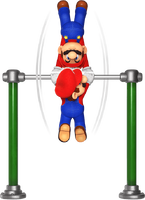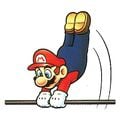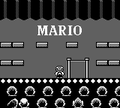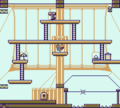Wire
- This article is about taut, swingable objects. For the elastic wired cables from Super Mario Sunshine, see rope.
| Wire | |
|---|---|
 Artwork from Mario vs. Donkey Kong | |
| First appearance | Donkey Kong (Game Boy) (1994) |
| Latest appearance | Mario vs. Donkey Kong (Nintendo Switch) (2024) |
Wires,[1] or bars,[2][3][4] are metal objects in the Super Mario franchise that the player character can swing from. The character will automatically grab onto one on contact. Depending on the game, flicking the control stick or pressing the action button will cause the character to start swinging. Letting go at the apex propels the character high into the air, allowing them to access heights that they otherwise would not be able to reach.
Though inconsistent, the term "wire" is generally applied to taut power cables that span across opposite walls or towers. The ones discontinuous with opposing walls are typically referred to as "bars", and are more recurring in the Super Mario franchise. They resemble horizontal bars.
Wires are comparable to horizontally-strung ropes and trapezes.
History
Donkey Kong franchise
Donkey Kong (Game Boy)
Ropes,[5] also called horizontal bars,[6] appear in Donkey Kong for the Game Boy, where they are attached to transmission towers. Mario can grab on and move across ropes and can also do the Wire Spin to either do a small jump or a large jump to get to areas he could not reach. Ropes are either diagonal or horizontal, which can help make Mario ascend heights or traverse gaps. Enemies called Wire Traps sometimes appear along ropes.
The wire ropes from Super Mario Sunshine share some traits and were potentially derived from these ropes, but they are more elastic and can by walked across like tightropes.
Mario vs. Donkey Kong
The objects reappear in Mario vs. Donkey Kong and the Nintendo Switch remake, this time referred to as wires or bars.[2] They behave exactly the same as they did in Donkey Kong.
Super Mario series
Super Mario Galaxy
Bars appear in Super Mario Galaxy, exclusively on the walls of the Deep Dark Galaxy. They are silvery with light-orange ends in this game, and provide a limited range for the player character to jump off. If the character jumps onto a bar with maintained momentum, they will automatically be swung forward, enabling them to immediately be swung forward and reach the apex without needing to tilt the control stick. Bars are clustered together and evenly spaced apart, allowing the player to swing from one to another in rapid succession.
Super Mario Galaxy 2
Bars, referred to as "nails" in the Prima Games guidebook,[7] return in Super Mario Galaxy 2, behaving as they did in the previous game. Bars only appear in the Clockwork Ruins Galaxy. They are used in the mission "Time for Adventure", where they must be used to reach the Power Star. The bars look rusted in this game, matching the aesthetic theming of the Clockwork Ruins Galaxy.
Super Mario Odyssey
In Super Mario Odyssey, bars are red with gray, reflective orbs at the end. They are embedded into the walls of subareas in the Metro Kingdom and Snow Kingdom. In the Wooded Kingdom, there are multiple Timer Challengess where bars briefly appear on the sides of terrain once Mario tosses Cappy at a Scarecrow. In the Hanging from a High-Rise subarea in the Metro Kingdom, bars are attached to a cross-shape apparatus that rotates every few seconds, after which they stop and shake before rotating again. Mario can grab on to these bars and jump from them.
On the streets of New Donk City, the overhanging traffic lights function exactly like bars.
Wario Land: Shake It!
Bars appear suspended in the air in Wario Land: Shake It! When clinging to a bar, Wario performs a move called the Bar Spin if the player shakes the ![]() . Pressing
. Pressing ![]() while spinning allows the player to move him to a subsequent bar. Bars are significant components in the boss battle against Chortlebot.
while spinning allows the player to move him to a subsequent bar. Bars are significant components in the boss battle against Chortlebot.
Gallery
Names in other languages
| Language | Name | Meaning |
|---|---|---|
| Japanese | ワイヤー[8][9] Waiyā 鉄棒[10][11] Tetsubō ロープ[12] Rōpu |
Wire Horizontal Bar Rope (Donkey Kong) |
| French | Câble[13] Barre[14] |
Cable Bar |
| German | Stange[15] |
Bar |
| Italian | Parallela[16] |
Parallel bar |
| Spanish | Cable[17] Barra[18][19] |
Cable Bar |
See also
Horizontal Bar, a Gymnastics Event from Mario & Sonic at the London 2012 Olympic Games
References
- ^ Nintendo (2004). Mario vs. Donkey Kong: Instruction Booklet. Großostheim: Nintendo of Europe. Page 5, 7, 18.
- ^ a b "You can use bars to jump higher." – Nintendo (2011). Mario vs. Donkey Kong (in-game eGuide for the Nintendo 3DS rerelease). Nintendo, Co. Ltd. Page 12.
- ^ Nintendo (2008). Wario Land: Shake It!: Instruction Booklet. Redmond: Nintendo of America. Page 4.
- ^ Walsh, Doug, and Joe Epstein (2017). Super Mario Odyssey: PRIMA Official Game Guide. Roseville: Prima Games. Page 99, 102, 105, 107, 145.
- ^ "Jump onto a rope .While Mario hangs from it, press ▲ on the +Control Pad. Mario will then beginning spinning. Press the A Button again and due to the centrifugal force, he can jump higher and further. [sic]" – Nintendo (1994). Donkey Kong: Instruction Booklet. Redmond: Nintendo of America. Page 11.
- ^ "Mario must gracefully swing from the horizontal bar to make it to the next platform." – Moyse, Claude M., Andreas G. Kämmerer, Marcus Menold, and Jeff Running, editors (1994). The Super Game Boy Player's Guide. Redmond: Nintendo of America. Page 36.
- ^ Browne, Catherine (2010). Super Mario Galaxy 2: PRIMA Official Game Guide (Premiere Edition). Roseville: Prima Games. Page 220.
- ^ Mario vs. Donkey Kong Shogakukan book
- ^ Mario vs. Donkey Kong Japanese instruction booklet, page 4.
- ^ Nintendo, Co. Ltd. (2004). "Action & Puzzle." Mario vs. Donkey Kong. Retrieved 22 Feb. 2024.
- ^ Sakai, Kazuya (Ambit), kikai, Akinori Sao, Junko Fukuda, Kunio Takayama, and Ko Nakahara (Shogakukan), editors. (2015). 『スーパーマリオブラザーズ百科: 任天堂公式ガイドブック』. Tokyo: Shogakukan (Japanese). Page 136, 170.
- ^ Game Boy Donkey Kong Japanese instruction booklet, page 9.
- ^ Mario vs. Donkey Kong European instruction booklet, page 58.
- ^ Nintendo (2008). Wario Land: Shake It!: Instruction Booklet. Redmond: Nintendo of America (French). Page 13.
- ^ Mario vs. Donkey Kong European instruction booklet, page 38.
- ^ Mario vs. Donkey Kong European instruction booklet, page 118.
- ^ Official Mario vs. Donkey Kong website (Guías Nintendo)
- ^ Mario vs. Donkey Kong European instruction booklet, page 98.
- ^ Nintendo (2008). Wario Land: Shake It!: Instruction Booklet. Redmond: Nintendo of America (Spanish). Page 30.
















